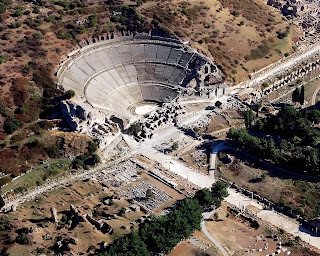Have you ever wondered what it would be like to step back in time and witness the glory of an ancient civilization? The Great Theater of Ephesus offers just that - a breathtaking glimpse into the past that will leave you in awe. In this blog post, we'll unravel the mysteries of this architectural marvel and reveal why it continues to captivate visitors from around the world.
The Magnificent Great Theater of Ephesus: A Testament to Roman Engineering
The Great Theater of Ephesus, located near modern-day Selçuk in Turkey, is a sight to behold. Nestled on the slope of Panayir Hill and overlooking the ancient harbor road, this monumental structure could accommodate an astonishing 25,000 spectators. It was a masterpiece of Roman engineering, showcasing the ingenuity and grandeur of the empire.
Construction of the theater began in the Hellenistic period during the reign of Lysimachus in the 3rd century B.C. However, it wasn't until the time of Emperor Trajan (98-117 A.D.) that the theater was finally completed. The Romans expanded and enhanced the original Greek design, creating a venue that would host performances, religious ceremonies, and even gladiatorial contests.
Unveiling the Secrets of the Theater's Design
The Great Theater of Ephesus was built entirely of gleaming white marble, a testament to the wealth and prestige of the city. The cavea, or seating area, was divided into three horizontal sections by diazomata (walkways). Sixty-six rows of seats ascended the slope, providing unobstructed views of the stage.
Recent archaeological discoveries have shed new light on the theater's intricate design. A 3.5-foot monument found on the street connecting the theater to the stadium bears an inscription from the guild of Ephesian silversmiths, the same group that played a central role in the riot against the Apostle Paul described in Acts 19.
The Theater's Role in Ephesian Society and Beyond
The Great Theater served as the cultural heart of Ephesus, hosting a wide array of events that drew crowds from across the Roman Empire. From dramatic performances and musical concerts to religious festivals and political assemblies, the theater was a hub of activity.
Its influence extended far beyond the city limits. The theater's renown attracted visitors from distant lands, making Ephesus a cosmopolitan center of art, learning, and commerce. Even today, nearly 2,000 years after its construction, the Great Theater continues to inspire and educate, drawing tourists and scholars alike to study its enduring legacy.
Experience the Wonders of Ephesus with FreeAstroScience.com
At FreeAstroScience.com, we're passionate about bringing the wonders of the ancient world to life. Our team of experts has crafted this in-depth look at the Great Theater of Ephesus to ignite your curiosity and inspire your own journey of discovery.
As you explore the theater's history and marvel at its architectural splendor, remember that you're standing in the footsteps of countless generations who have been captivated by its beauty. The Great Theater of Ephesus is more than just a relic of the past; it's a living testament to the enduring power of human creativity and the timeless allure of the ancient world.
Conclusion
The Great Theater of Ephesus stands as a remarkable example of Roman engineering and cultural achievement. From its humble beginnings in the Hellenistic era to its final form under Emperor Trajan, the theater has witnessed the rise and fall of empires, the birth of new religions, and the enduring spirit of human creativity. As you contemplate its grandeur, let the Great Theater of Ephesus inspire you to embrace the wonders of the past and carry their lessons into the future.
Related Sources
- Foss, C. (1979). Ephesus after antiquity: A late antique, Byzantine, and Turkish city. Cambridge University Press.
- Scherrer, P. (2000). Ephesus: The new guide. Ege Yayinlari.
- Koester, H. (Ed.). (2004). Ephesos, metropolis of Asia: An interdisciplinary approach to its archaeology, religion, and culture. Harvard University Press.
- Baugh, S. M. (2016). Paul and Ephesus: The Apostle among his contemporaries. Lexham Press.


Post a Comment